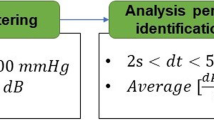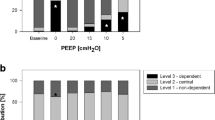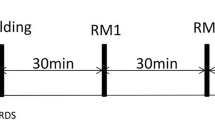Abstract
Objective
To test the usefulness of dead space for determining open-lung PEEP, the lowest PEEP that prevents lung collapse after a lung recruitment maneuver.
Design
Prospective animal study.
Setting
Department of Clinical Physiology, University of Uppsala, Sweden.
Subjects
Eight lung-lavaged pigs.
Interventions
Animals were ventilated using constant flow mode with VT of 6 ml/kg, respiratory rate of 30 bpm, inspiratory-to-expiratory ratio of 1 : 2, and FiO2 of 1. Baseline measurements were performed at 6 cmH2O of PEEP. PEEP was increased in steps of 6 cmH2O from 6 to 24 cmH2O. Recruitment maneuver was achieved within 2 min at pressure levels of 60/30 cmH2O for Peak/PEEP. PEEP was decreased from 24 to 6 cmH2O in steps of 2 cmH2O and then to 0 cmH2O. Each PEEP step was maintained for 10 min.
Measurements and results
Alveolar dead space (VDalv), the ratio of alveolar dead space to alveolar tidal volume (VDalv/VTalv), and the arterial to end-tidal PCO2 difference (Pa-etCO2) showed a good correlation with PaO2, normally aerated areas, and non-aerated CT areas in all animals (minimum–maximum r2 = 0.83–0.99; p < 0.01). Lung collapse (non-aerated tissue > 5%) started at 12 cmH2O PEEP; hence, open-lung PEEP was established at 14 cmH2O. The receiver operating characteristics curve demonstrated a high specificity and sensitivity of VDalv (0.89 and 0.90), VDalv/VTalv (0.82 and 1.00), and Pa − etCO2 (0.93 and 0.95) for detecting lung collapse.
Conclusions
Monitoring of dead space was useful for detecting lung collapse and for establishing open-lung PEEP after a recruitment maneuver.




Similar content being viewed by others
References
Gattinoni L, Pelosi A, Crott S, Valenza F (1995) Effects of positive end-expiratory pressure on regional distribution of tidal volume and recruitment in adult respiratory distress syndrome. Am J Respir Crit Care Med 151:1807–1814
Puybasset L, Cluzel P, Chao N, Slutsky AS, Coriat P, Rouby JJ (1998) A computed tomography scans assessment of regional lung volume in acute lung injury. Am J Respir Crit Care Med 158:1644–1655
The Acute Respiratory Distress Syndrome Network (2004) Ventilation with lower tidal volumes as compared with traditional tidal volumes for acute lung injury and the acute respiratory distress syndrome. N Engl J Med 342:1301–1308
Reber A, Endberg G, Wegenius G, Hedenstierna G (1996) Lung aeration: the effect of pre-oxygenation and hyperoxygenation during total intravenous anesthesia. Anesthesia 51:733–777
Reissmann H, Böhm SH, Suarez-Sipmann F, Tusman G, Buschmann C, Maisch S, Pesch T, Tham O, Plumers C, Schulte am Esch J, Hedenstierna G (2005) Suctioning through a double-lumen endotracheal tube helps to prevent alveolar collapse and to preserve ventilation. Intensive Care Med 31:431–440
Muscedere JG, Mullen JBM, Gan K, Bryan AC, Slutsky AS (1994) Tidal ventilation at low airway pressures can augment lung injury. Am J Respir Crit Care Med 149:1327–1334
Abraham E, Andrews P, Antonelli M, Brochard L, Brun-Buisson C, Dobb G, Fagon J-Y, Groeneveld J, Mancebo J, Metnitz P, Nava S, Pinsky M, Radermacher P, Ranieri M, Richard C, Tasker R, Vallet B (2004) Year in review in Intensive Care Medicine, 2003. I. Respiratory failure, infection and sepsis. Intensive Care Med 30:1017–1031
Andrews P, Azoulay E, Antonelli M, Brochard L, Brun-Buisson C, de Backer D, Dobb G, Fagon J-Y, Gerlach H, Groeneveld J, Mancebo J, Metnitz P, Nava S, Pugin J, Pinsky M, Radermacher P, Richard C, Tasker R (2006) Year in review in Intensive Care Medicine, 2005. I. Acute respiratory failure and acute lung injury, ventilation, hemodynamics, education, renal failure. Intensive Care Med 32:207–216
Lachmann B (1992) Open up the lung and keep the lung open. Intensive Care Med 118:319–321
Rothen HU, Sporre B, Wegenius G, Hedenstierna G (1993) Reexpansion of atelectasis during general anaesthesia: a computed tomography study. Br J Anaesth 71:788–795
Amato MBP, Barbas CSV, Medeiros DM, Magaldi RB, Schettino GP, Lorenzi-Filho G, Kairalla RA, Deheinzelin D, Munoz C, Oliveira R, Takagaki TY, Carvalho CR (1998) Effect of a protective-ventilation strategy on mortality in the acute respiratory distress syndrome. N Engl J Med 338:347–354
Tusman G, Böhm SH, Vazquez de Anda GF, do Campo JL, Lachmann B (1999) “Alveolar Recruitment Strategy” improved arterial oxygenation during general anaesthesia. Br J Anaesth 82:8–13
Richard JC, Maggiore SM, Mercat A (2004) Clinical review: bedside assessment of alveolar recruitment. Crit Care Med 8:163–169
Malbouisson LM, Muller JC, Constantin JM, Lu Q, Puybasset L, Rouby JJ (2001) Computed tomography assessment of positive end-expiratory pressure-induced alveolar recruitment in patients with acute respiratory distress syndrome. Am J Respir Crit Care Med 163:1444–1450
Hickling KG (2001) Best compliance during a decremental, but not incremental, positive end-expiratory pressure trial is related to open-lung positive end-expiratory pressure. A mathematical model of acute respiratory distress syndrome lungs. Am J Respir Crit Care Med 163:69–78
Rouby JJ, Lu Q, Goldstein I (2002) Selecting the right level of positive end-expiratory pressure in patients with acute respiratory distress syndrome. Am J Respir Crit Care Med 165:1186–1186
Ranieri M, Zhang H, Mascia L, Aubin M, Lin C, Mullen B, Grasso S, Binnie M, Volgyesi GA, Slutsky AS (2000) Pressure-time curve predicts minimally injurious ventilatory strategy in an isolated rat lung model. Anesthesiology 93:1320–1328
Sipmann FS, Böhm SH, Tusman G, Reissmann H, Pesch T, Thamm O, Hedenstierna G (2004) Selecting Open Lung PEEP in an experimental model of ARDS: comparison of oxygenation and compliance with CT scan. Am J Resp Crit Care Med 169:A721
Enghoff H (1938) Volume inefficax. Bemerkungen zur Frage des schädlichen Raumes. Upsala Läkaref Förh 44:191–218
Fowler WS (1948) Lung function studies. II. The respiratory dead space. Am J Physiol 154:405–416
Fletcher R, Jonson B (1981) The concept of deadspace with special reference to the single breath test for carbon dioxide. Br J Anaesth 53:77–88
Breen PH, Mazumdar B (1996) How does positive end-expiratory pressure decrease CO2 elimination from the lung? Respir Physiol 103:233–242
Tusman G, Böhm SH, Suárez Sipmann F, Turchetto E (2004) Alveolar recruitment improves ventilatory efficiency of the lungs during anesthesia. Can J Anesth 51:723–727
Tusman G, Böhm SH, Suárez Sipmann F, Maisch S (2004) Lung recruitment improves the efficiency of ventilation and gas exchange during one-lung ventilation anesthesia. Anesth Analg 98:1604–1609
Suter PM, Fairley B, Isenberg MD (1975) Optimum end-expiratory pressure in patients with acute pulmonary failure. N Engl J Med 292:284–289
McMahon SM, Halprin GM, Sieker HO (1973) Positive end-expiratory airway pressure in severe arterial hypoxemia. Am Rev Respir Dis 108:526–535
Blanch LL, Lucangelo U, Lopez-Aguilar J, Fernandez R, Romero PV (1999) Volumetric capnography in patients with acute lung injury: effect of positive end-expiratory pressure. Eur Respir J 13:1048–1054
Beydon L, Uttman L, Rawal R, Jonson B (2002) Effects of positive end-expiratory pressure on dead space and its partitions in acute lung injury. Intensive Care Med 28:1239–1245
Berggren SM (1942) The oxygen deficit of arterial blood caused by non-ventilated parts of the lung. Acta Physiol Scand (Suppl 4):4–92
Breen PH, Mazumdar B, Skinner SC (1996) Comparison of end-tidal PCO2 and average alveolar expired PCO2 during positive end-expiratory pressure. Anesth Analg 82:368–373
Gattinoni L, Caironi P, Pelosi P, Goodman LR (2001) What has computed tomography taught us about the acute respiratory distress syndrome. Am J Respir Crit Care Med 164:1701–1711
Lachmann B, Jonson B, Lindroth M, Robertson B (1982) Modes of artificial ventilation in severe respiratory distress syndrome. Lung function and morphology in rabbits after wash-out of alveolar surfactant. Crit Care Med 10:724–732
Bernard GR, Artigas A, Brigham KL, Carlet J, Falke K, Hudson L, Lamy M, Legall JR, Morris A, Spragg R (1994) The American-European Consensus Conference on ARDS: definitions, mechanisms, relevant outcomes, and clinical trial coordination. Am J Respir Crit Care Med 149:818–824
Gattinoni L, Vagginelli F, Carlesso E, Taccone P, Conte V, Chiumello D, Valenza F, Caironi P, Pesenti A (2003) Decrease in PaCO2 with prone position is predictive of improved outcome in acute distress syndrome. Crit Care Med 31:2727–2733
Hedenstierna G, Lundberg S (1975) Airway compliance during artificial ventilation. Br J Anaesth 47:1227–1232
Wenzel U, Rüdiger M, Wagner MH, Wauer RR (1999) Utility of deadspace and capnometry measurements in determination of surfactant efficacy in surfactant-depleted lungs. Crit Care Med 27:946–952
Van der Kloot TE, Blanch L, Youngblood AM, Weinert C, Adams AB, Marini JJ, Shapiro RS, Nahum A (2000) Recruitment maneuvers in three experimental models of acute lung injury: Effects on lung volume and gas exchange. Am J Respir Crit Care Med 161:1485–1494
Rosenthal C, Caronia C, Quinn C, Lugo N, Sagy M (1998) A comparison among animal models of acute lung injury. Crit Care Med 26:912–916
Vieira SRR, Puybasset L, Richecoeur J, Lu Q, Cluzel P, Gusman PB, Coriat P, Rouby JJ (1998) A lung computed tomographic assessment of positive end-expiratory pressure-induced lung overdistension. Am J Respir Crit Care Med 158:1571–1577
Acknowledgements
We thank A. Roneus, E.-M. Hedin, K. Fagerbrink (laboratory assistants at the Department of Medical Sciences, Clinical Physiology, University Hospital, Uppsala Sweden), and O. Thamm (medical student at Department of Anesthesiology, University Hospital, Hamburg-Eppendorf, Hamburg, Germany) for their invaluable assistance, and I. Passoni (Department of Bioengineering, University of Mar del Plata, Argentina) for her expert help with data analysis. This work was performed in the Department of Medical Sciences, Clinical Physiology, University Hospital, Uppsala Sweden. Support was provided by the Swedish Medical Research Council (5315), the Swedish Heart-Lung Fund and Maquet Critical Care.
Author information
Authors and Affiliations
Corresponding author
Additional information
This article is discussed in the editorial available at: http://dx.doi.org/10.1007/s00134-006-0372-6
Rights and permissions
About this article
Cite this article
Tusman, G., Suarez-Sipmann, F., Böhm, S.H. et al. Monitoring dead space during recruitment and PEEP titration in an experimental model. Intensive Care Med 32, 1863–1871 (2006). https://doi.org/10.1007/s00134-006-0371-7
Received:
Accepted:
Published:
Issue Date:
DOI: https://doi.org/10.1007/s00134-006-0371-7




